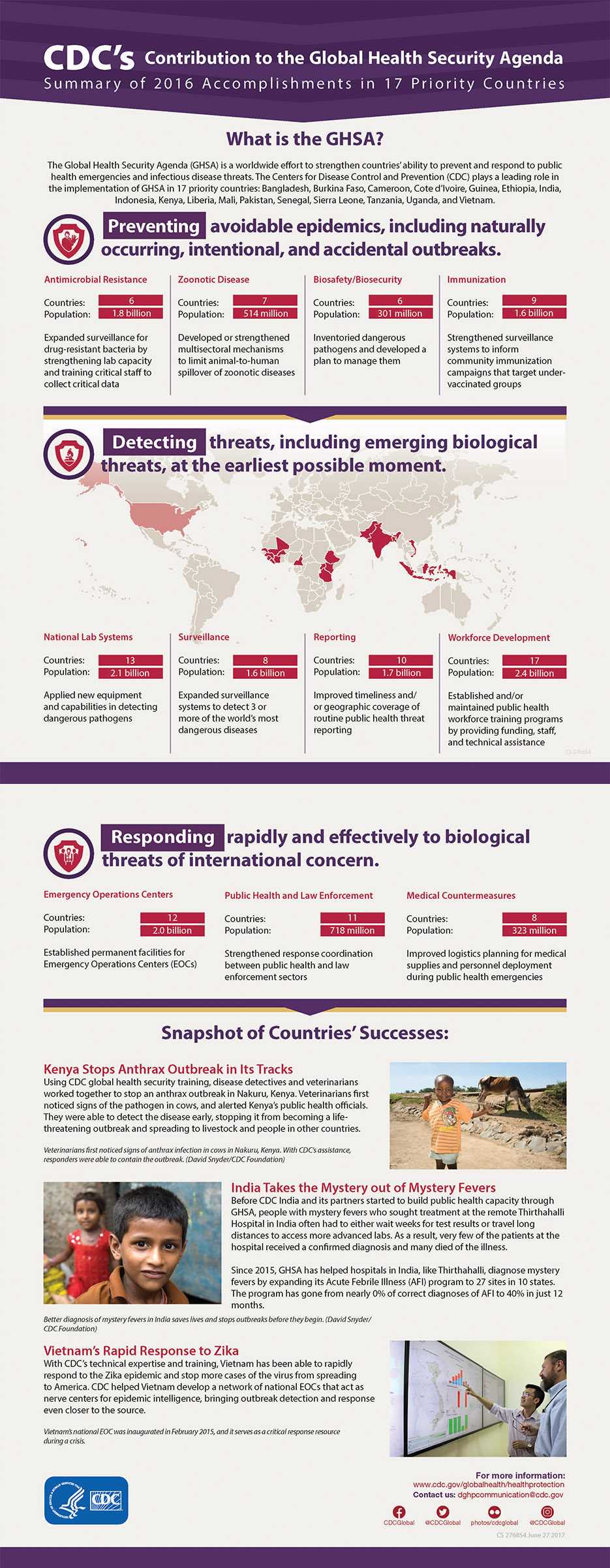Infographic: CDC's Contribution to the Global Health Security Agenda
Download infographic pdf [2.4MB]

CDC’s Contribution to the Global Health Security Agenda
Summary of 2016 Accomplishments in 17 Priority Countries
What is the GHSA?
The Global Health Security Agenda (GHSA) is a worldwide effort to strengthen countries’ ability to prevent and respond to public health emergencies and infectious disease threats. The Centers for Disease Control and Prevention (CDC) plays a leading role in the implementation of GHSA in 17 priority countries: Bangladesh, Burkina Faso, Cameroon, Côte d’Ivoire, Guinea, Ethiopia, India, Indonesia, Kenya, Liberia, Mali, Pakistan, Senegal, Sierra Leone, Tanzania, Uganda, and Vietnam.
Illustration of shield containing person holding hand like a stop sign
Preventing avoidable epidemics, including naturally occurring, intentional, and accidental outbreaks.
| Antimicrobial Resistance | Zoonotic Disease | Biosafety/Biosecurity | Immunization |
|---|---|---|---|
| Countries: 6 Population: 1.8 Billion Expanded surveillance for drug-resistant bacteria by strengthening lab capacity and training critical staff to collect critical data |
Countries: 7 Population: 514 million Developed or strengthened multisectoral mechanisms to limit animal-to-human spillover of zoonotic diseases |
Countries: 6 Population: 301 million Inventoried dangerous pathogens and developed a plan to manage them |
Countries: 9 Population: 1.6 billion Strengthened surveillance systems to inform community immunization campaigns that target under-vaccinated groups |
Illustration of microscope inside a shield
Detecting threats, including emerging biological threats, at the earliest possible moment.
Illustration of global map with involved countries highlighted
| National Lab Systems | Surveillance | Reporting | Workforce Development |
|---|---|---|---|
| Countries: 13 Population: 2.1 Billion Applied new equipment and capabilities in detecting dangerous pathogens |
Countries: 8 Population: 1.6 billion Expanded surveillance systems to detect 3 or more of the world’s most dangerous diseases |
Countries: 10 Population: 1.7 billion Improved timelines and/or geographic coverage of routine public health threat reporting |
Countries: 17 Population: 2.4 billion Established and/or maintained public health workforce training programs by providing funding, staff, and technical assistance |
Illustration of shield containing first responders
Responding rapidly and effectively to biological threats of international concern.
| Emergency Operations Centers | Public Health and Law Enforcement | Medical Countermeasures |
|---|---|---|
| Countries: 12 Population: 2.0 Billion Established permanent facilities for Emergency Operations Centers (EOCs) |
Countries: 11 Population: 718 million Strengthened response coordination between public health and law enforcement sectors |
Countries: 8 Population: 323 million Improved logistics planning for medical supplies and personnel deployment during public health emergencies |
Snapshot of Countries’ Successes:
Kenya Stops Anthrax Outbreak in Its Tracks
Using CDC global health security training, disease detectives and veterinarians worked together to stop an anthrax outbreak in Nakuru, Kenya. Veterinarians first noticed signs of the pathogen in cows, and alerted Kenya’s public health officials. They were able to detect the disease early, stopping it from becoming a life-threatening outbreak and spreading to livestock and people in other countries.
Caption for photo on right side of page: Veterinarians first noticed signs of anthrax infection in cows in Nakuru, Kenya. With CDC’s assistance,
responders were able to contain the outbreak. (David Snyder/CDC Foundation)
Photo of young boy in front of a cow in Nakuru, Kenya.
Photo of young boy and girl in India. Better diagnosis of mystery fevers in India saves lives and stops outbreaks before they begin. (David Snyder/CDC Foundation)
India Takes the Mystery out of Mystery Fevers
Before CDC India and its partners started to build public health capacity through GHSA, people with mystery fevers who sought treatment at the remote Thirthahalli Hospital in India often had to either wait weeks for test results or travel long distances to access more advanced labs. As a result, very few of the patients at the hospital received a confirmed diagnosis and many died of the illness.
Since 2015, GHSA has helped hospitals in India, like Thirthahalli, diagnose mystery fevers by expanding its Acute Febrile Illness (AFI) program to 27 sites in 10 states. The program has gone from nearly 0% of correct diagnoses of AFI to 40% in just 12 months.
Vietnam’s Rapid Response to Zika
With CDC’s technical expertise and training, Vietnam has been able to rapidly respond to the Zika epidemic and stop more cases of the virus from spreading to America. CDC helped Vietnam develop a network of national EOCs that act as nerve centers for epidemic intelligence, bringing outbreak detection and response even closer to the source.
Caption for photo on right side of page: Vietnam’s national EOC was inaugurated in February 2015, and it serves as a critical response resource during a crisis. Photo of two people in Vietnam’s national EOC reviewing metrics.
HHS logo
CDC logo
For more information:
www.cdc.gov/globalhealth/healthprotection
Contact us:dghpcommunication@cdc.gov
Facebook logo: CDCGlobal
Twitter logo: @CDCGlobal
Flickr logo: photos/cdcglobal
Instagram logo: @CDCGlobal
- Page last reviewed: June 30, 2017
- Page last updated: June 30, 2017
- Content source:


 ShareCompartir
ShareCompartir